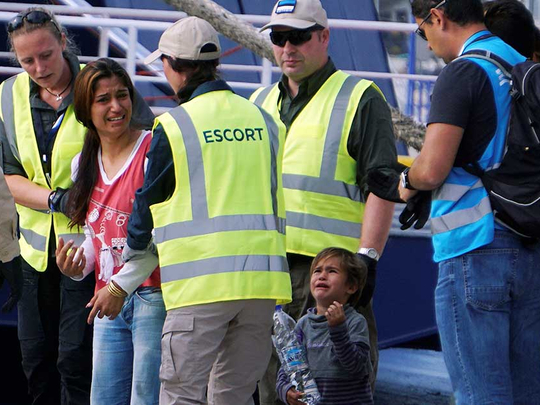
KAPITAN-ANDREEVO, Bulgaria: The EU’s beefed-up version of its struggling border force goes into operation Thursday, as the squabbling bloc struggles to find a unified strategy to tackle its worst refugee and migration crisis since World War II.
European Union officials were due to inaugurate the new task force at the Kapitan-Andreevo checkpoint on the Bulgarian-Turkish border, the main land frontier via which refugees and migrants try to enter the bloc to avoid the dangerous Mediterranean Sea crossing.
The European Border and Coast Guard Agency (EBCG) will have at the ready some 1,500 officers from 19 member states who can be swiftly mobilised in case of emergency such as a sudden rush of refugees and migrants.
Brussels hopes the revamped agency will not just increase security, but also help heal the huge rifts that have emerged between western and eastern member states clashing over the EU’s refugee policies.
The long-term goal is to lift the border controls inside the bloc and restore the passport-free Schengen Zone.
A day before attending the launch, EU Migration Commissioner Dimitris Avramopoulos hailed the inauguration as a “historic moment” for Europe.
The boosted force is an expansion of Frontex, founded in 2004 to help coordinate Europe-wide efforts to combat people smuggling and illegal migration.
The agency, based in Warsaw, proved inefficient last year when it was caught off guard by the hundreds of thousands of people that began trekking up from Greece along the so-called western Balkan route towards northern Europe.
With limited staffing levels and powers, Frontex was unable to effectively patrol the EU’s external borders, including of frontline countries Greece and Italy where most refugees and migrants enter.
The uncontrolled arrival of well over a million people, many fleeing war in Syria, triggered chaos on the continent, prompting key transit nations along the refugee and migrant trail to seal their borders with fences.
The flow also sparked fierce tensions inside the bloc, with eastern and central European nations lambasting Germany’s “open door” policy which they say allowed Islamist radicals to pose as refugees and help carry out attacks inside Europe.
However, in a rare show of unity, all 28 member states agreed on the creation of the new border agency earlier this year.
Crucially, it “will provide support to all member states and be able to identify and intervene to address weaknesses in advance, and not when it’s too late,” the European Commission, the EU’s executive arm, said in a statement in June.
The agency will also be involved in the repatriation of migrants whose asylum claims have been rejected or who are considered a security threat.
“[The agency] represents a boost for our efforts to guarantee the safety of Bulgarian and European citizens,” Bulgarian Prime Minister Boyko Borisov said recently.
Bulgaria has already strung up a barbed wire fence that will soon cover most of its 259-kilometre (160-mile) border with Turkey.
The estimated 13,000 refugees and migrants stranded inside the country remain modest compared to the 60,000 stuck in Greece or the 140,000 who have crossed the Mediterranean to Italy so far this year.
But with its migrant centres overflowing, the EU’s poorest member is still worried it will become a “buffer state” if a shaky EU deal with Turkey breaks down after the July coup attempt.
It is unclear how the new border force will help tackle the growing influx from North Africa to Italy.
More than 3,500 refugees and migrants have drowned in the Mediterranean so far this year, latest figures show.
— AFP












